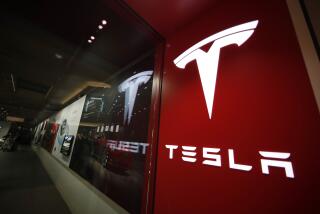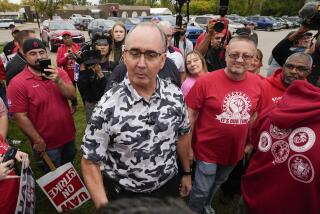Chrysler Lays Lower Profit to Incentives
- Share via
DETROIT — Forced to offer costly sales incentives to curb a dramatic erosion in its share of the domestic car market, Chrysler said Tuesday that its earnings plunged more than 47% in the second quarter.
The auto maker reported a profit of $180 million for the three months, down from $341 million during the 1989 period. Revenue totaled $8.85 billion--$1 billion less than in 1989’s second quarter.
Chrysler joins its larger domestic rivals, General Motors and Ford, in posting an earnings falloff just as the U.S. auto industry begins serious negotiations with the United Auto Workers union on a new national labor agreement.
Chrysler has asked the UAW to consider its smaller size and weakened financial position during the contract talks; the company wants to break out of the industrywide “pattern bargaining” through which the UAW seeks to impose the same contract on all of the major auto makers.
Chrysler has also suggested a plan that would give union employees a share of the company in exchange for reduced health and labor costs, but the union leadership has rejected both proposals.
Last week, Ford said its profit for the period fell 45% from last year’s pace, while GM announced that its earnings dropped 40%.
The slump in profitability comes amid Chrysler’s efforts to stave off Honda, which is threatening Chrysler’s hold on the No. 3 auto sales ranking in the United States. To generate the cash needed to pay for an expensive redesign of its cars and trucks, the heart of its $15-billion product program, Chrysler has tried to shed many of the non-automotive operations that it acquired during its highly profitable years in the mid-1980s.
Still, the firm’s share of the passenger car market is in its worst decline in years--at a time when Honda and other major Japanese auto makers are expanding their assembly operations in the United States. In the second quarter, Chrysler’s market share fell to 8.9%, down from 10.7% during the second quarter of last year. In fact, Chrysler now sells more trucks--including minivans and Jeep utility vehicles--than it does passenger cars. But its combined car and truck market share has also slipped to 11.7%, down from last year’s 13.9%.
Although Chrysler works furiously to introduce newer products, it is stuck with trying to sell an aging lineup of cars that holds little appeal for younger and more affluent consumers. To push those cars during a slump in the overall car market, Chrysler has offered rebates and other incentives that have had a big impact on the bottom line, according to Chrysler Chairman Lee A. Iacocca.
“If not for the huge year-to-year increase in per-unit incentive costs, we would have made more money this quarter than we did in the second quarter of 1989,” Iacocca insisted Tuesday.






